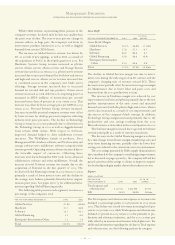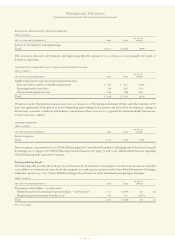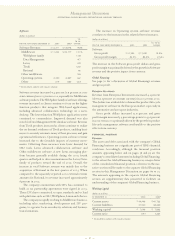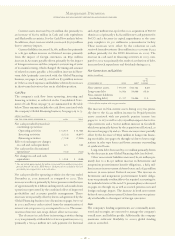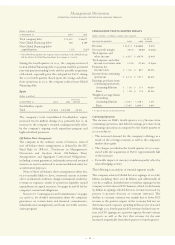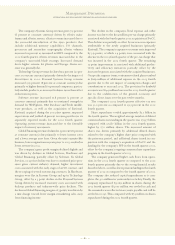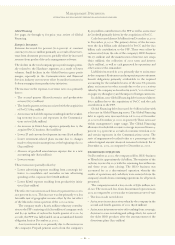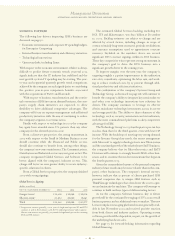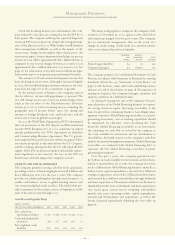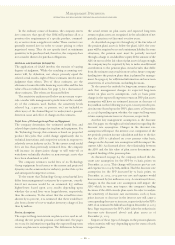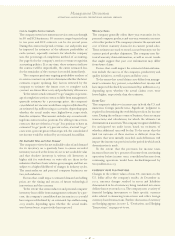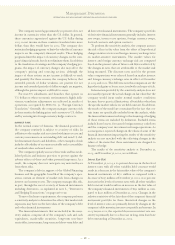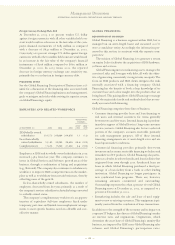IBM 2003 Annual Report Download - page 64
Download and view the complete annual report
Please find page 64 of the 2003 IBM annual report below. You can navigate through the pages in the report by either clicking on the pages listed below, or by using the keyword search tool below to find specific information within the annual report.
Global Financing
See pages 69 through 73 for prior year review of Global
Financing.
Enterprise Investments
Revenue decreased 8.6 percent (10.6 percent at constant
currency) to $1,022 million primarily as a result of lower rev-
enue from document processors, partially offset by increased
revenue from product life-cycle management software.
The decline in the total company gross profit margin prima-
rily related to the Hardware segments as a result of lower
volumes. Small declines in the Global Services gross profit
margin, especially in the Communications and Financial
Services industry sectors were offset by modest increases in
Software margins from productivity initiatives.
The increase in the expense-to-revenue ratio was primarily
due to:
•The second quarter Microelectronics and productivity
actions ($1,727 million)
•The fourth quarter actions associated with the acquisition
of PwCC ($614 million)
•An increase in bad debt expense resulting from the weaken-
ing economy in 2002 and exposures in the Communica-
tions sector ($183 million)
•An increase in SG&A-base expenses primarily due to the
acquired PwCC business ($161 million)
•Lower IP and custom development income ($376 million)
•Lower retirement-related plans income due to changes
made to the pension assumptions at the beginning of 2002
($245 million)
•Absence of goodwill amortization expense due to a new
accounting rule ($262 million)
•Lower revenue
These items were partially offset by:
•Lower advertising expense resulting from a strategic ini-
tiative to consolidate and centralize certain advertising
spending at the corporate level ($188 million)
•Lower RD&E expense resulting from productivity initia-
tives ($236 million)
The effective tax rate increased from 28.9 percent in 2001 to
29.1 percent in 2002. This increase was due primarily to a less
favorable mix of geographic income offset by the tax effect
of the Microelectronics portion of the 2002 actions.
The company made a $3,963 million voluntary contribu-
tion to the PPP consisting of $1,871 million of company stock
and $2,092 million of cash in the fourth quarter of 2002. As
a result, the PPP was fully funded on an accumulated benefit
obligation basis at December 31, 2002.
Assets increased in 2002 primarily due to the increase in
the company’s Prepaid pension assets from the company’s
$3,963 million contribution to the PPP as well as an increase
in Goodwill primarily driven by the acquisition of PwCC.
Cash decreased almost $1 billion from December 31, 2001
to December 31, 2002. The primary drivers of the decrease
were the $2.9 billion cash disbursed for PwCC and the $2.1
billion cash contribution to the PPP. These were offset by
cash received from the sale of the company’s HDD business
($1,170 million) and the monetization of interest rate swaps
($650 million), the collection of 2001 taxes and interest
($460 million), as well as cash generated by operations and
other sources (the remainder).
Liabilities increased in 2002 primarily due to an increase
in the company’s Retirement and nonpension postretirement
benefit obligations primarily attributable to the required
accounting for the unfunded status of the non-U.S. pension
plans, an increase in other accruals due to the 2002 actions
taken by the company as described in note S, “2002 Actions,”
on pages 105 through 107 and the impact of foreign currencies.
In addition, non-Global Financing debt increased almost
$600 million due to the acquisition of PwCC and the cash
contribution to the PPP.
Global Financing debt decreased $1.7 billion in line with
a decrease in Global Financing assets. The Global Financing
debt to equity ratio increased from 6.8 to 6.9 at December
31, 2001 to December 31, 2002, respectively. These ratios are
within management’s target range. The Global Financing
allowance for doubtful accounts coverage increased from 2.4
percent to 3.5 percent as a result of economic trends in 2002
and certain exposures in the Communications sector. The
ratio of unguaranteed residual value as a percentage of the
related original amount financed remained relatively flat at
December 31, 2002, as compared to December 31, 2001.
DISCONTINUED OPERATIONS
On December 31, 2002, the company sold its HDD business
to Hitachi for approximately $2 billion. The majority of the
cash was received in 2002 with the remaining due within one
and three years after closing. The HDD business was
accounted for as a discontinued operation whereby the
results of operations and cash flows were removed from the
company’s results from continuing operations for all periods
presented.
The company incurred a loss on sale of $382 million, net-
of-tax. The increased loss from discontinued operations in
2002 as compared to 2001 was due to (amounts are net-of-tax):
•The loss on sale noted above
•An increase in certain actions taken by the company in the
second and fourth quarters of 2002 ($508 million)
•An increase in inventory write-offs resulting from a strategic
decision to cease reworking and selling efforts for some of
the older HDD products after the announcement of the
divestiture plans ($217 million)
Management Discussion
INTERNATIONAL BUSINESS MACHINES CORPORATION AND SUBSIDIARY COMPANIES
62


